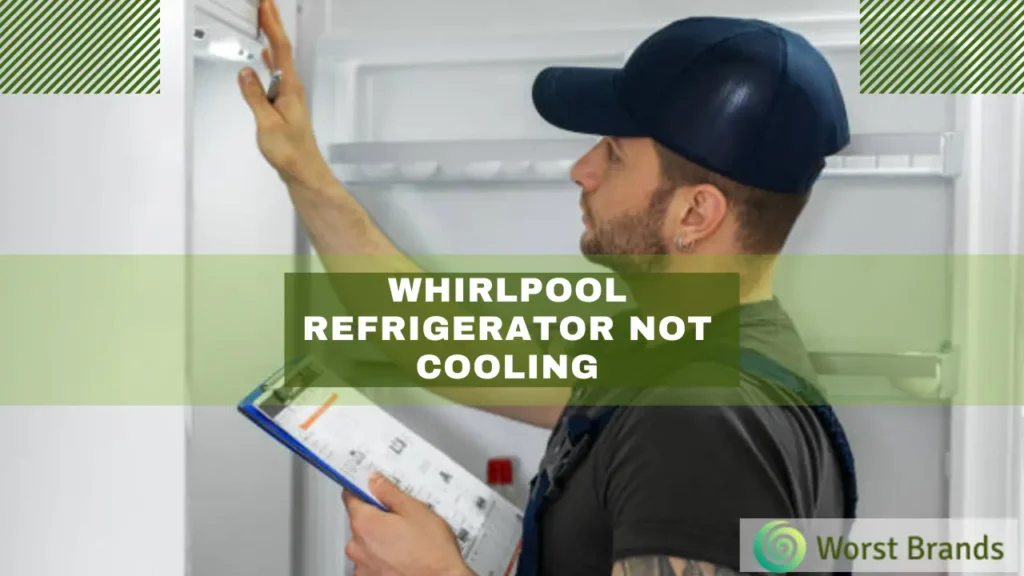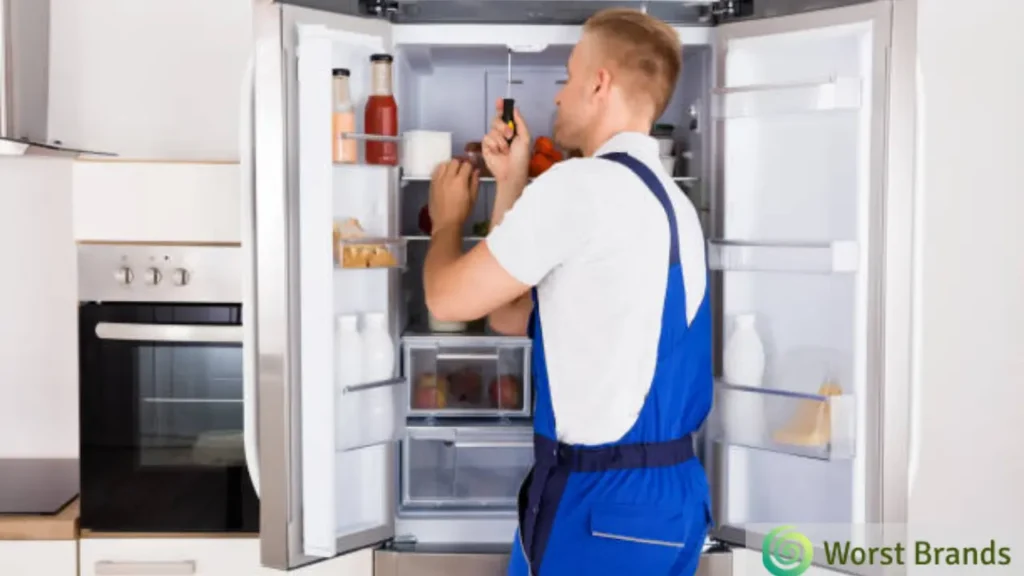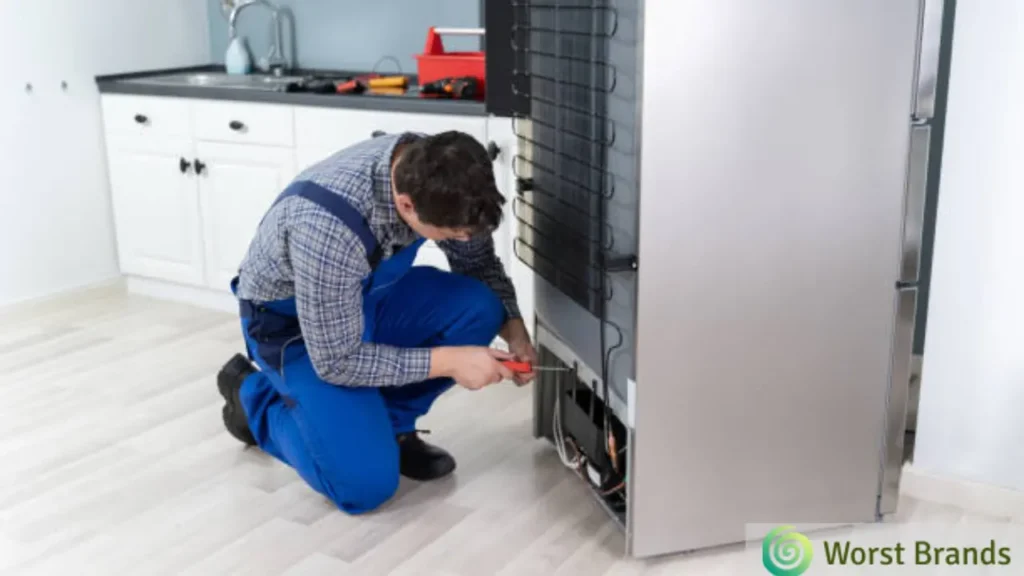Opening the refrigerator door and being blasted with warm air is a scary situation for any homeowner.
If your Whirlpool refrigerator is not cooling properly, even when the internal fan is still running, it likely indicates a malfunction that needs troubleshooting.
Not only will food spoil quickly in a non-functioning refrigerator, but you may also lose hundreds of dollars in replacing perished food.
The good news is that with some basic DIY troubleshooting steps, you can often resolve common Whirlpool fridge cooling issues and get your appliance back to keeping food chilled.
We’ll walk you through several troubleshooting tips to help get your Whirlpool refrigerator back to cooling before you need to call in costly appliance repair service.

Table of Contents
- Why Whirlpool Fridge Won’t Cool?
- How to Fix Whirlpool Refrigerator Not Cooling?
- 1. Adjusting Incorrect Temperature Settings
- 2. Dealing with Overstocking
- 3. Cleaning Blocked or Dirty Condenser Coils
- 4. Power Supply and Electrical Issues
- 5. Fixing a Malfunctioning Evaporator Fan Motor
- 6. Ensuring Door Seals are Functional
- 7. Thermostat Functionality Check
- 8. Refrigerant Issues
- 9. Condenser Fan Motor Malfunction
- 10. Clearing Clogged Vents
- 11. Resolving Compressor Complications
- 12. Addressing Defrost System Failures
- Conclusion
- Steven Settles
Why Whirlpool Fridge Won’t Cool?
Common problems that could lead your Whirlpool refrigerator not cooling include incorrect temperature settings, a crowded fridge interior, or even power supply issues.
Sometimes, even with the Whirlpool fridge fan running, the unit fails to cool effectively, hinting at potential disruptions in other components.
Here is a list of the most recurring issues why your Whirlpool refrigerator won’t cool properly.
- Incorrect temperature settings
- Overstocking obstructing airflow
- Blocked or dirty condenser coils
- Faulty power supply or electrical issues
- Malfunctioning evaporator fan motor
- Compromised door seals or gaskets
- Dysfunctional thermostat
- Refrigerant issues
- Condenser fan motor failure
- Clogged vents or air circulation problems
- Overworked or failing fridge compressor
- Defrost system malfunctions
How to Fix Whirlpool Refrigerator Not Cooling?
The maze of potential issues leading to your Whirlpool refrigerator not freezing or cooling can be daunting.
Below, we have accurately dissected each problem and present actionable fixes to restore the Whirlpool fridge.
1. Adjusting Incorrect Temperature Settings
Incorrectly set temperatures can cause your refrigerator to feel warmer than the Arctic chill you aim for.
This could be the simplest reason why your Whirlpool fridge is not cooling effectively. Yet, it’s often overlooked in the troubleshooting process.
Easy Fix:
Dial in the ideal temperature settings: 37°F for the refrigerator and 0°F for the freezer. These are the USDA-recommended settings for safe food storage.
Access your Whirlpool’s control panel and adjust accordingly. Wait at least 24 hours for the temperature to stabilize; this patience often pays off with the return of your fridge’s cooling capabilities.
2. Dealing with Overstocking
A fridge crammed with groceries can block vents and impede air circulation, leading to uneven cooling.
Even if the Whirlpool fridge fan is running, crowded conditions can prevent cool air from reaching all areas within.
Easy Fix:
Organize your refrigerator’s interior to ensure unobstructed airflow. Remove excess items, particularly near the vents, and rearrange the remaining items for optimal space distribution.
Maintaining a clean layout allows for efficient air movement and a uniformly cool environment.

3. Cleaning Blocked or Dirty Condenser Coils
The condenser coils, when congested with debris and dust, lose their efficiency in dissipating heat away from your refrigerator.
This is a common Whirlpool refrigerator problem yet often neglected. It could comprise the fridge’s freezing ability.
Easy Fix:
Integrate coil cleaning into your semi-annual home maintenance checklist to prevent this from becoming a roadblock in your appliance’s performance.
Slide the fridge forward, unplug it for safety, and locate the coils.
With a coil brush or a vacuum with a soft brush attachment, gently but thoroughly remove any dust and dirt from the coils.
Restoring these coils to their original cleanliness can significantly improve your refrigerator’s cooling process, making this a key step in repairing your Whirlpool refrigerator.
4. Power Supply and Electrical Issues
With a consistent power supply, your refrigerator can maintain its cool.
This could be due to an unplugged cord, a tripped circuit breaker, or even a malfunctioning outlet.
Easy Fix:
First, ensure the refrigerator plug is firmly in the wall socket. Inspect the cord for damage. If all looks well, check your home’s electrical panel for a tripped circuit breaker.
Resetting the breaker can often jumpstart the appliance back to life. If the outlet is faulty, you may need an electrician’s expertise to resolve the issue.
5. Fixing a Malfunctioning Evaporator Fan Motor
An unresponsive evaporator fan motor can be deceptive and is a sign of deeper issues. It’s imperative in the air circulation chain, driving cool air across compartments.
A failure could be the weak link in your Whirlpool’s cooling efficiency, often misdiagnosed or overlooked during casual inspections.

Easy Fix:
Addressing a malfunctioning evaporator fan motor requires more elbow grease but is crucial for restoring full functionality.
Safety first—unplug your fridge before embarking on this task. Dismantle the freezer’s interior panels to expose the fan.
Once you’ve ensured no obstructions and the fan spins freely, use a multimeter to test the motor’s continuity.
If the test fails, it’s clear that the fan motor needs replacing. It is a critical step in troubleshooting Whirlpool refrigerators that can restore your unit to its optimum cooling state without professional intervention.
6. Ensuring Door Seals are Functional
If cold air escapes from the refrigerator due to worn or damaged door seals, it will struggle to maintain the set temperature. This can result in a Whirlpool fridge not freezing properly.
Easy Fix:
Inspect the seals around the door for any signs of damage or wear. Perform the dollar-bill test; close the door on a bill and pull. If it slides out easily, it’s time to replace the seals.
Whirlpool refrigerator door seals are readily available and can be replaced without professional help.
7. Thermostat Functionality Check
A dysfunctional thermostat can lead to a lack of cooling in your refrigerator, as it regulates the temperature.
Easy Fix:
Test the thermostat by turning it from the lowest to the highest setting and listen for the click sound that indicates it’s working.
If there’s no click, or if a multimeter test does not show continuity, you’ll need to replace the thermostat.
8. Refrigerant Issues
The refrigerant is the circulatory system of the cooling process within your Whirlpool fridge.
Levels that are too low due to leaks or other issues can halt the entire cooling function, resulting in a refrigerator that operates in silence, devoid of its usual hum of activity.

Easy Fix:
Tackling refrigerant problems is not a DIY fix and requires the expertise of a certified technician.
They are equipped with the tools and knowledge to handle these substances safely and are trained to repair leaks, ensuring your refrigerator returns to its optimal cooling state.
9. Condenser Fan Motor Malfunction
Similar to the evaporator fan, the condenser fan plays a crucial role.
If your Whirlpool fridge compressor is not working, it may be due to a defective condenser fan motor.
Easy Fix:
With the fridge unplugged, locate the condenser fan motor and clear any obstructions.
Check for blade movement and test the motor with a multimeter for continuity. If the fan is blocked or the motor has failed, it’s time for a replacement.
10. Clearing Clogged Vents
Your refrigerator’s vents are pivotal in ensuring a consistent flow of cool air to every corner of the unit.
When these vents become clogged with food particles or debris, it leads to patchy cooling zones, with certain areas failing to reach the desired chill.
Easy Fix:
Regular inspections can keep these airways clear. Take a moment to scan the interior of your refrigerator, rearranging any items that may be encroaching on the vent spaces.
Incorporating a routine vent cleaning can drastically improve air circulation and distribution, mitigating any risk of warm spots that can affect food preservation.
11. Resolving Compressor Complications
The compressor’s role in refrigeration is irreplaceable, compressing the refrigerant and propelling it through the coils.
Signs of a struggling compressor can include the fridge running too warm, strange noises, or not running at all.
The same issue also results in the Whirlpool fridge not making ice problems.
Easy Fix:
A malfunctioning compressor is a serious matter and often signifies a major repair or the end of the refrigerator’s lifecycle. Professional assessment is paramount here.
Technicians can measure compressor health, evaluate cost-effective solutions, and, if necessary, perform safe removal and replacement.
This level of intervention goes beyond regular maintenance.
Still, prompt action can sometimes save a refrigerator from the brink, especially if it’s a high-end model or part of a custom kitchen design.
12. Addressing Defrost System Failures
A failing defrost system can lead to frost buildup, which insulates and prevents the evaporator coils from cooling the air effectively.
Easy Fix:
Start manual defrosting by unplugging your Whirlpool refrigerator and allowing it to thaw can be a temporary solution.
However, if the defrost system is malfunctioning, parts such as the defrost timer, heater, or thermostat may need inspection and replacement by a professional.
Conclusion
Before you let the stress of potential food loss or costly repairs overwhelm you, take a deep breath. The power to troubleshoot your Whirlpool refrigerator not cooling lies in your hands.
The solutions we’ve explored offer hope for every homeowner facing this chilly predicament.
From clearing vents to recalibrating thermostats, each step is a stride towards reclaiming the cool sanctuary your fridge once was.
Remember, the most persistent problems often have the simplest fixes.
Should the chill continue to elude you, knowing you’ve given your best shot will make the call to a professional a confident decision, not a desperate measure.
Keep this guide handy, for the next time your refrigerator’s hum grows silent, you’ll know exactly where to start.

Steven Settles is an ISCET-certified master in appliance repair. He has aced the National Appliance Service Technician Certification Exam, showcasing his exceptional diagnostic and repair skills. With an in-depth understanding of the latest repair technologies and a keen eye on evolving industry standards, Steven is a go-to expert for any appliance issue.